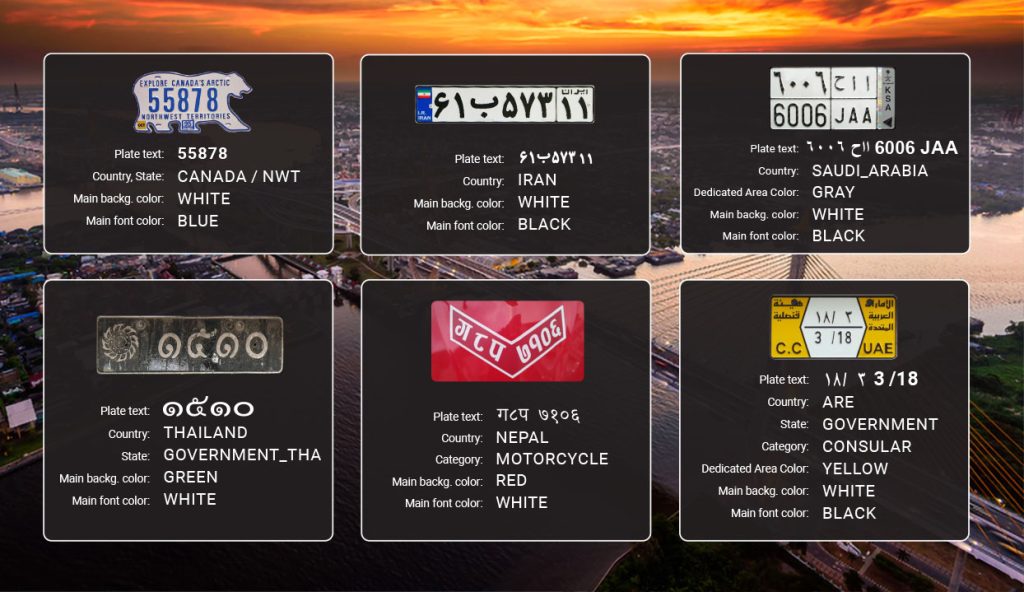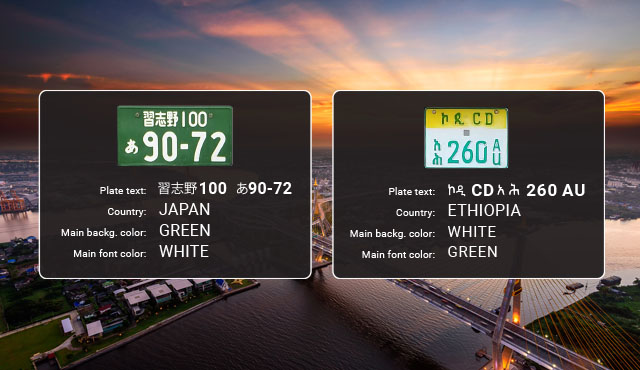Our Carmen® ANPR software is trained to recognize license plates of all types. These metal rectangles with characters and numbers can be captured as an image and processed by automatic number plate recognition cameras and software to identify the vehicle and its driver. Regarding standard license plates, recognition is usually easy for ANPR (also known as LPR for license plate recognition) software. Achieving close to 100% ANPR accuracy is possible under favorable lighting and weather conditions.
However, license plates can come in many forms and shapes. In this article, I collected some of the world’s most unusual, extraordinary, and exotic license plates that owners of ANPR projects have to face. They seem different, but there is one thing common in all of them: they pose a significant challenge for any ALPR project. Let’s see them one by one.
Unfamiliar shape
Canada
First in line of unusual license plates are Canada’s polar bear-shaped ones, a little off the traditional rectangular format. However, ANPR software can be trained to recognize this shape and process the characters and numbers that can identify the vehicle.
Sophisticated ALPR software doesn’t even rely on the shape of the license plate exclusively but performs more complex examinations of the image, such as the character arrangement and the syntax. Other number plate recognition solutions differentiate between the plate’s character and background based on contrast.

Unique arrangements
Japan
In Japan, it is not the shape of the license plate but rather a stacked multi-row arrangement of the characters that cause the biggest headache to license plate recognition project owners. Furthermore, the plates contain kanji and hiragana characters, indicating the issuing office and the vehicle, respectively. To complicate things, some license plates come with jikō-shiki – glowing characters for special cars. A nightmare for plate recognition software.
United Arab Emirates
In the United Arab Emirates, vehicles belonging to consulates have very different license plates than privately owned cars. These plates typically contain a combination of Arabic characters and Latin numbers that are presented in a hexagonal shape. However, the outer yellow-colored region also plays a role, helping ALPR software to identify the plate type.
In advanced ANPR software like Carmen®, users can specify if they wish to recognize Latin or Arabic characters or both. This means that regardless of the plate’s character set, the automatic number plate recognition engine is guaranteed to properly return it.

Local characters
Iran
At first glance, Iran’s license plates seem to be similar to those in Europe. However, they use neither Arabic nor Latin characters. They are written in Persian, making them unique and challenging to read for ANPR software.
The plates are divided into two zones. The primary identifiers are located in the middle, while the word “Iran” is written in Persian above the additional two numerical identifiers on the right. Thankfully, Persian is a language that Carmen® FreeFlow can easily interpret into data.
Nepal
In Nepal, before 2020, license plates such as the one above were standard. These license plates are special for at least three reasons. First, they contain Nepali characters. Second, they have a red background color. Finally, they are painted on the vehicle in the styles of the chrome “V” Cadillacs from the 1950s.
Bangladesh
As we have seen, local characters on license plates can make automatic number plate recognition challenging. For license plates of Bangladesh using the Bangla/Bengali alphabet, these difficulties are topped by the unique distribution of identifiers.
This license plate issued in 2019 contains two rows. While the first row shows the registration city and a letter for the vehicle’s class, the second has a two-digit number, also representing the vehicle’s class, as well as a four-digit unique identifier. The unique identifiers are present in the form of a four-digit number. The white background of the license plate shows that this example plate belongs to a privately owned vehicle. In contrast, public vehicles are distinguished with a green background.
A bit of trivia: in Bangladesh, a license plate is assigned to a vehicle until it’s sold for scrap. That’s why the rear license plate is permanently attached to the car. Not a problem for most ANPR software: these can identify license plates in the front or the rear of the vehicle too.
Advanced combinations
Ethiopia
License plates from Ethiopia combine the challenges that Japanese and Iranian plates pose, namely the use of stacked characters and letters from a language unique to the region.
In addition, the characters on the plate come from Ge’ez, a language exclusively used for liturgical purposes only. Yet it’s been present on all Ethiopian license plates since 1942.
The latest series of plates—introduced in 2002—contain Latin characters as well to indicate the region or autonomous city in which it was issued. The example on the image shows a license plate issued for a vehicle used by the African Union (AU) presiding at the Ethiopian capital of Addis Abeba, returned correctly by the ANPR software.
Characters from more than one alphabet
Saudi Arabia
License plates issued by the government of Saudi Arabia are divided into four plus one cells. The upper two cells contain numbers and characters in Arabic, while the lower two cells repeat the same combination in Latin. Meanwhile, the fifth cell contains the official abbreviation of the state, KSA, and a symbol representing the vehicle category. This latter is also represented by the background color of the cell.
The main challenge for automatic license plate recognition project owners facing Saudi license plates is to capture all information on the plate: the Latin and Arabic characters, numbers, and the background color representing the vehicle type.
Different background colors for authorities and residents
Thailand
In Thailand, governmental bodies, such as the sovereign, the Bureau of the Royal Household, the Royal Thai Police, and the Royal Armed Forces, do not fall under the jurisdiction of the Department of Land Transport of Thailand. Vehicles of these bodies sometimes contain prefixes or emblems.
This example shows a license plate of the armed forces that features Thai characters only, without a single number. The special black background color indicates that the vehicle is not used for combats.
Wrapping Up
In this article, we had a look at some of the world’s most unusual and sometimes shocking license plates and saw why they mean a challenge for ANPR projects. Although they may come across as photoshopped, trust me, they are 100% real.
Thanks to advanced features and continuous development, most ALPR software on the market, including our Carmen® FreeFlow can tackle these challenges. Unfamiliar shapes, local characters, or multi-row arrangements: however unconventional these license plates may be, automatic number plate recognition solutions must retract all necessary data when facing them.
Do you want to learn more about how they do this? Get in touch with us for more information:

